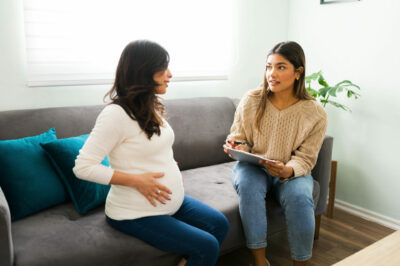What Is Group B Strep In Pregnancy?
Group B Streptococcus (also referred to as Group B Strep or GBS) is a type of bacteria that resides in the vagina, urinary tract or rectum of about 25% of all women according to the CDC. GBS rarely causes a problem for mothers, but during birth may be passed to the baby.
Providers in the U.S. test for Group B Strep around 36 weeks of pregnancy. Although it is typically harmless, even when passed to the newborn, it can sometimes make babies very sick.
Early-onset Group B Strep disease shows up on baby’s first day, usually within the first hour, and almost always within 24-48 hours (Source). Early-onset GBS can be prevented with antibiotics in labor. Late-onset GBS disease occurs in infants 7+ days old (Source). We will be focusing on early-onset in this post.
Are Some People More Likely to Have Group B Strep?
Research has found that young, non-pregnant women with these criteria may be more likely to carry Group B Strep:
- Having multiple sex partners
- Engaging in male-to-female oral sex
- Having had frequent or recent sex
- > than 20 years old
- Use of tampons
- Infrequent hand washing
How Does the Group B Strep Test Work?
Around 36 weeks of pregnancy your provider will do a swab test and send it to the lab to test for the presence of GBS bacteria. The provider swabs your vagina and rectum and the lab waits to see if GBS grows in the sample. It takes about 48 hours to get the results back.
If the test comes back negative, there’s about a 90% chance you are and will be negative in labor. No antibiotics will be given.
If the test comes back positive, there’s about an 84% chance you’ll be positive in labor and antibiotics will be recommended. Research shows that about 16% of people who test positive are in fact negative by the time they go into labor (Source).
How Many Babies Get Group B Strep?
One in four pregnant women test positive for Group B Strep. About 50% of babies born to a GBS+ carrier who received no treatment will be colonized. This means that if you have GBS when your baby is born and don’t get antibiotics, there is a 50/50 chance the bacteria will be passed on to your baby.
This does NOT mean your baby will be sick. Furthermore, the clear majority of these babies show no signs of infection or illness.
Only one in 100 (1/100) of those babies will develop a life-threatening infection (Source).
Of the full-term babies who are infected, 97-98% of them survive. Premature babies are at significantly higher risk.
Antibiotics in labor lower the rate of infection. It’s not 100% effective, but about 80-90% fewer babies are infected when antibiotics are given in labor.
Babies are at Higher Risk of Group B Strep if:
- They are premature
- Your water is broken for a long time
- You have a fever in labor
How is Group B Strep Treated?
In the U.S., the standard of care is to administer IV antibiotics every 4-6 hours in labor (beginning more than 4 hours before baby is born) to anyone who tests positive at any point in pregnancy. This is known as the “universal approach” because all are screened at 35-37 weeks and all who are positive are treated with antibiotics in labor. Recent evidence supports this approach in treating Group B Strep infection.
In the U.K., a “risk-based” approach is currently taken. This approach treats women in labor with antibiotics only if you have one or more of the following risk factors:
- GBS in the urine at any time during your pregnancy
- You previously had a baby with an early onset GBS infection
- You go into labor earlier than 37 weeks
- While in labor you have a fever
- Your water has been broken for longer than 18 hours
Several large studies in the U.S. have shown that treating all GBS-positive pregnant women with antibiotics during labor is more effective at lowering rates of GBS infections than treating with antibiotics based on risk factors alone (Source).
If I Have to Take Antibiotics, Does this Mean I will Have to be Hooked Up to an IV?
The antibiotic drip only takes 10-15 minutes to get into your IV, so you do not have to be attached to a pole for your whole labor. The nurse can seal your IV with a hep-lock so that you can be untethered but keep the catheter for the next dose. This way you don’t have a tube and the nurse doesn’t have to stick you again.
In most cases, penicillin (Category B) is used. There are other options if you are allergic to penicillin.
Are There Potential Side Effects to Treating GBS with Antibiotics in Labor?
Yes. As with most things, there are both potential benefits and potential side effects related to screening for GBS and giving antibiotics– talk with your healthcare provider about what is best for you.
Potential side effects of IV Antibiotics in Labor:
- Rare severe allergic reactions. The risk is estimated to be 1/10,000 for a severe reaction, and 1/100,000 for a fatal reaction. (Source).
- May cause a short-term negative effect on the infant’s microbiome; however, most infants microbiomes will recover. Recovery is helped by breastfeeding.
- An increased chance of maternal and newborn yeast infections (Source).
- Other potential side effects are due to the antibiotic that is used. You can click to see a complete list of potential side effects for the most common antibiotics: penicillin, ampicillin, cefazolin.
Can I Get Rid of Group B Strep?
The transitory nature of Group B Strep (like most microbiota) means that you can have it one day and not the next. So, you may test negative at 36 weeks and be positive when you give birth or test positive in pregnancy and be negative the day your baby is born.
About 84% of people who test positive at 36 weeks still have GBS in labor.
There is some evidence that your lifestyle and habits can prevent colonization with GBS. Vaginal probiotics can remove GBS from the birth canal. The first randomized trial that used probiotics to reduce GBS in pregnant women had great results – 43% of GBS positive women became GBS negative by the time they gave birth (Source).
If you want to test and stay GBS negative, you can try eating less sugar or take probiotics orally and/or vaginally. There is not great research to support any of these practices for limiting GBS exposure and risk to babies at the time of birth, but these are healthy practices anyway. Remember to check with your provider; also, remember that you can be recolonized any time—for example by your sexual partner.
Are There Other Options for GBS Besides Antibiotics?
Are you concerned about taking antibiotics? Talk to your provider about taking a risk-based approach. If you have risk factors for infection, antibiotics can be given in labor.
In the U.K. and New Zealand, there is no routine testing for GBS in pregnancy. Antibiotics are only given in labor when there are high-risk factors.
Your provider may be sensitive to the wish to avoid antibiotic resistance and wiping out the personal microbiome.
Some midwives offer chlorhexidine vaginally. Often called by its brand name, Hibiclens, chlorhexidine is a topical disinfectant. It kills bacteria on contact and has been proven to wipe GBS from the vagina for 3-6 hours. Unfortunately, this doesn’t prevent the bacteria from ascending from your vagina into the amniotic fluid if your water is broken. Hibiclens can be effective in certain situations, but there is not enough evidence to show that it is useful in preventing early GBS infections (Source).
Can My Baby get GBS from People Touching her?
The research is clear on early GBS—babies are colonized during labor. Babies can catch “late-onset” GBS disease from people who handle the baby in the hospital or anyone who touches the baby. This is another reason why it’s so important for anyone who touches the baby to wash their hands first, especially in the early days.
Disclaimer: Pregnancy by Design’s information is not a substitute for professional medical advice or treatment. Always ask your healthcare provider about any health concerns you may have.
Cited Resources:
Benitz, W., Gould, J., and Druzin, M. (1999). Preventing early-onset group B stretococcal sepsis: strategy development using decision analysis.
Boyer & Gotoff (1985). Prevention of early-onset neonatal group B streptococcal disease with selective intrapartum chemoprophylaxis.
Adair, C. E., L. Kowalsky, et al. (2003). Risk factors for early-onset group B streptococcal disease in neonates: a population-based case-control study. CMAJ 169(3): 198-203.
Boyer, K. M. and S. P. Gotoff (1985). Strategies for chemoprophylaxis of GBS early-onset infections. Antibiot Chemother 35: 267-280.
CDC, (2010). Prevention of perinatal group b streptococcal disease. MMWR 59: 1-32.
CDC, (2018). About Group B Strep, fast facts.
Dinsmoor, M. J., R. Viloria, et al. (2005). Use of intrapartum antibiotics and the incidence of postnatal maternal and neonatal yeast infections. Obstetrics and gynecology 106(1): 19-22.
Feigin, R. D., J. D. Cherry, et al. (2009). Textbook of Pediatric Infectious Diseases, Saunders.
Glasgow et al. (2005). Association of intrapartum antibiotic exposure and late-onset serious bacterial infections in infants.
Goldenberg, R. L., E. M. McClure, et al. (2006). Use of vaginally administered chlorhexidine during labor to improve pregnancy outcomes. Obstetrics and Gynecology 107(5): 1139-1146.
Heath, P. T., G. F. Balfour, et al. (2009). Group B streptococcal disease in infants: a case control study. Arch Dis Child 94(9): 674-680.
Ho, M., Chang, Y., Chang, W. (2016). Oral Lactobacillus rhamnosusGR-1 and Lactobacillus reuteriRC-14 to reduce Group BStreptococcus colonization in pregnant women: A randomized controlled trial. Taiwan J Obstet Gynecol 55(4): 515-8.
Ohlsson, A. and V. S. Shah (2013). Intrapartum antibiotics for known maternal Group B streptococcal colonization. Cochrane Database Syst Rev 1: CD007467.
Schrag, S. J., E. R. Zell, et al. (2002). A population-based comparison of strategies to prevent early-onset group B streptococcal disease in neonates. N Engl J Med 347(4): 233-239.
Stade B, Shah V, Ohlsson A. (2004). Vaginal chlorhexidine during labour to prevent early-onset neonatal group B streptococcal infection.
Tudela, C. M., R. D. Stewart, et al. (2012). Intrapartum evidence of early-onset group B streptococcus. Obstetrics and Gynecology 119(3): 626-629.
Young, B. C., L. E. Dodge, et al. (2011). Evaluation of a rapid, real-time intrapartum group B streptococcus assay. Am J Obstet Gynecol 205(4): 372 e371-376.
Velaphi, S., J. D. Siegel, et al. (2003). Early-onset group B streptococcal infection after a combined maternal and neonatal group B streptococcal chemoprophylaxis strategy Pediatrics 111(3): 541-547.
Weiss, M. E. and N. F. Adkinson (1988). Immediate hypersensitivity reactions to penicillin and related antibiotics. Clin Allergy 18(6): 515-540.



 How Much Weight Should I Gain in Pregnancy?
How Much Weight Should I Gain in Pregnancy?






Leave a Reply